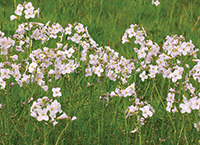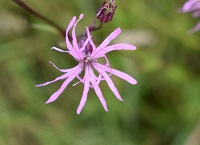25 August 2022
How will your acres score?

You can help address the challenges to our water, climate and biodiversity by joining ACRES (AgriClimate Rural Environment Scheme). Catherine Keena Environment specialist, Teagasc Crops, Environment and Land Use Programme takes us through the Results-based payments system of ACRES
Pictured above: Catherine Keena delivering a Teagasc AETS course in Longford, organised by colleagues Sean Doorley and Donal McCabe
If you are considering applying to join ACRES, you need to understand results-based payments. Advisors are currently delivering one-day courses under the Agri-Environment Training Scheme (AETS) to help prepare farmers for ACRES.
Results-based payments
The major difference in ACRES compared to previous agri-environment schemes will be the change from action-based payments to resultsbased payments, which is proposed for species-rich flowery grassland (LIG) and for uplands. The Hen Harrier Project, Pearl Mussel Project, Burren Programme, Wild Atlantic Nature LIFE IP and REAP already deliver results-based payments. If you are currently involved in the GLAS actions LIPP (Low Input Permanent Grassland) or THM (Traditional Hay Meadow), you need to assess your fields now to see how they will score in ACRES.
Which type of grassland do you have?
•Flower-rich grass fields – will be suited to LIG (Low Input Grassland) with the payment rate based on how it scores, up to a maximum of €450 per hectare, including the bonus of €50 for late-mown meadows.
•Grassy fields – little or no ryegrass with no flowers, which will be more suited to action-based extensive grassland with a proposed payment rate of €200 per hectare.



Beneficial Flowers above: Greater birds-foot trefoil | Lady’s smock or Cuckoo flower | Ragged robin
Assessing a field for LIG
The number of indicator flowering plant species is monitored. Not all flowers are relevant. Those found in agriculturally improved grassland, such as chickweed or dandelions for example, don’t count. A very high number, over 16, would gain the highest score of 20. Four or less gets a zero score. The level of cover of these indicator flowering plants is also important. Where they are dominant, or over 50% of the field, the maximum score of 25 is awarded, but if they are rare or only 5% of the field, no marks are awarded for cover.
Vegetation structure is assessed. A good structure is where the sward in over 50% of the field has a variety of taller and/or shorter sward with medium height sward throughout, with positive indicator plants flowering. Such good vegetation structure is awarded the maximum 20 marks. Both overgrazing and undergrazing are penalised, as they do not provide habitats where biodiversity can thrive.
A field is regarded as overgrazed when the sward is short throughout the grazeable area, with little variation in the height of vegetation and where over 75% of the sward is very short, with few flowering plants. Undergrazing results in rank vegetation across much of the field, with leaf litter accumulating and scrub encroaching.
Agriculturally favoured plants can reduce the field score in an LIG field. These include ryegrass, nettles, docks, ragwort and thistles (creeping and spear). There is negative marking where their combined cover is over 10% of the field. Their rare occurrence, on less than 5%, is rewarded with 10 marks.
Threats and pressures to LIG include the expansion of immature scrub, bracken, invasive alien species, bare soil and erosion and artificial drainage. Where these threats and pressures are not evident, you gain up to 25 marks, but their presence is negatively marked. Damaging activities to vegetation or soil are penalised, even where a small area is affected. Examples include quarrying, dumping, supplementary feeding, burning, herbicide or slurry spreading. Any evidence of damage to watercourses is also negatively marked.
Natural water sources rarely (or lightly) used due to adequate provision of water (in tanks or troughs) are not considered to be damaging.

Grassy margins
Farmers with Priority Environmental Assets, such as Natura areas or commonage, will get priority access to ACRES in Tier 1.
One action that some farmers can undertake to increase their chance of gaining access under Tier 2 is the creation of fenced grassy margins in either tillage or grassland.
Where whole farm stocking rate exceeds 130kg livestock manure N/ ha produced on the holding (whether beef, dairy or sheep), or is more than 30ha, undertaking at least one of the following actions will increase the chances of getting into ACRES as a Tier 2 applicant: minimum tillage, catch crops over winter stubble, grass margins, arable or grass margins, grassland or low input peat grassland. Grassy margins provide rough grass habitat, which is absent from many intensively managed farms.

Flowers that may mean money in ACRES
Uncultivated, unsprayed, fenced field margins allow the native rough grass margin to continue undisturbed, protecting soil biodiversity. Their presence and structure allows grasses and wildflowers to flower and seed, providing habitat for associated invertebrates, birds and small mammals. Birds such as linnet feed on grass seed. There is a high biodiversity value in any native plants growing wild naturally.
Other ACRES actions
With a proposed maximum of 15ha for LIG and 10ha for extensive grassland, there is potential for most farmers to undertake further actions.
Most of the actions available in GLAS will be available. Hedge planting is likely to be popular, using native species of Irish provenance. The planting of wild bird cover will not be a priority action in ACRES, but is a very valuable action for biodiversity and for farmers – where it suits the farm and farmer.
Creating watercourse margins and LESS (low emission slurry spreading) will be available to farmers where these actions are not mandatory under nitrates.

This article was first published in Today’s Farm – July/August 2022 where you can read more articles like this one.
Learn more about Biodiversity & Countryside from Teagasc
Hedgerow Week 2022 – “Best Practice Hedge Cutting” runs from Friday, 26th August – Friday 2nd September, to coincide with the opening of the hedge cutting season on 1 September. Watch out for articles here on Teagasc Daily
